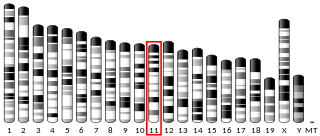
UDP-glucuronosyltransferase 1-1 also known as UGT-1A is an enzyme that in humans is encoded by the UGT1A1 gene.

Olfactory receptor 1D2 is a protein that in humans is encoded by the OR1D2 gene.

UDP-glucuronosyltransferase 1-6 is an enzyme that in humans is encoded by the UGT1A6 gene.

UDP-glucuronosyltransferase 1-10 is an enzyme that in humans is encoded by the UGT1A10 gene.

UDP-glucuronosyltransferase 2B15 is an enzyme that in humans is encoded by the UGT2B15 gene.

UDP-glucuronosyltransferase 1-3 is an enzyme that in humans is encoded by the UGT1A3 gene.

UDP-glucuronosyltransferase 1-4 is an enzyme that in humans is encoded by the UGT1A4 gene.

UDP glucuronosyltransferase 2 family, polypeptide B4, also known as UGT2B4, is an enzyme that in humans is encoded by the UGT2B4 gene.

Olfactory receptor 3A2 is a protein that in humans is encoded by the OR3A2 gene.

Olfactory receptor 1E2 is a protein that in humans is encoded by the OR1E2 gene.

Olfactory receptor 4F4 is a protein that in humans is encoded by the OR4F4 gene.

Olfactory receptor 1J2 is a protein that in humans is encoded by the OR1J2 gene.

2-hydroxyacylsphingosine 1-beta-galactosyltransferase is an enzyme that in humans is encoded by the UGT8 gene.

UDP-glucuronosyltransferase 2B17 is an enzyme that in humans is encoded by the UGT2B17 gene.
UDP glucuronosyltransferase 1 family, polypeptide A cluster (UGT1A) is a human gene locus which includes several UDP glucuronosyltransferases.

UDP-glucuronosyltransferase 2B10 is an enzyme that in humans is encoded by the UGT2B10 gene. It is responsible for glucuronidation of nicotine and cotinine.

UDP-glucuronosyltransferase 1-5 is an enzyme that in humans is encoded by the UGT1A5 gene.

UDP-glucuronosyltransferase 1-9 is an enzyme that in humans is encoded by the UGT1A9 gene.

UDP glucuronosyltransferase 2 family, polypeptide A2, also known as UGT2A2, is an enzyme that in humans is encoded by the UGT2A2 gene.

UDP glucuronosyltransferase 1 family, polypeptide A7 is a protein that in humans is encoded by the UGT1A7 gene.










